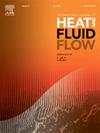Numerical study on heat and mass transfer characteristics in the spray zone for an improved closed-type heat source tower
IF 2.6
3区 工程技术
Q2 ENGINEERING, MECHANICAL
International Journal of Heat and Fluid Flow
Pub Date : 2025-01-29
DOI:10.1016/j.ijheatfluidflow.2025.109761
引用次数: 0
Abstract
It is of great scientific significance to strengthen the heat transfer process in the closed-type heat source tower by improving its structure and operation mode. In this study, an improved closed-type heat source tower was proposed, which uses spray zone instead of finned tube heat exchanger to solve the disadvantages of traditional heat exchanger such as high air flow resistance and local frost formation. On this basis, an improved transient numerical model of spray zone in the closed-type heat source tower was established, and the effects of mass flow rate, initial temperature of the spray solution, velocity and spray angle on heat and mass transfer characteristics were studied. The results show that the effect of velocity on the transfer rate of sensible and latent heat is different. When the velocity of humid air exceeds 1.2 m/s, it will cause the sensible heat transfer rate to decrease slightly; however, it promotes the transfer rate of latent heat significantly, resulting in greater dilution of the spray solution. When the spray angle is between 100° and 120°, the total heat transfer rate increases by about 6 % for every 10° increase in spray angle. However, excessive spray angle will cause the droplets to adhere to the wall, thus increasing latent heat transfer and weakening sensible heat transfer rates. Additionally, the mass flow rate of the spray solution has a significant impact on both sensible heat and latent heat transfer, but the initial temperature only has a remarkable influence on sensible heat transfer. Finally, the optimal combination of axial relative velocity, spray angle, mass flow rate and initial temperature of spray solution is given based on response surface analysis, which are 3.7 m/s, 102.9°, 1.5 kg/s and −7.4 °C, respectively.
求助全文
约1分钟内获得全文
求助全文
来源期刊

International Journal of Heat and Fluid Flow
工程技术-工程:机械
CiteScore
5.00
自引率
7.70%
发文量
131
审稿时长
33 days
期刊介绍:
The International Journal of Heat and Fluid Flow welcomes high-quality original contributions on experimental, computational, and physical aspects of convective heat transfer and fluid dynamics relevant to engineering or the environment, including multiphase and microscale flows.
Papers reporting the application of these disciplines to design and development, with emphasis on new technological fields, are also welcomed. Some of these new fields include microscale electronic and mechanical systems; medical and biological systems; and thermal and flow control in both the internal and external environment.
 求助内容:
求助内容: 应助结果提醒方式:
应助结果提醒方式:


